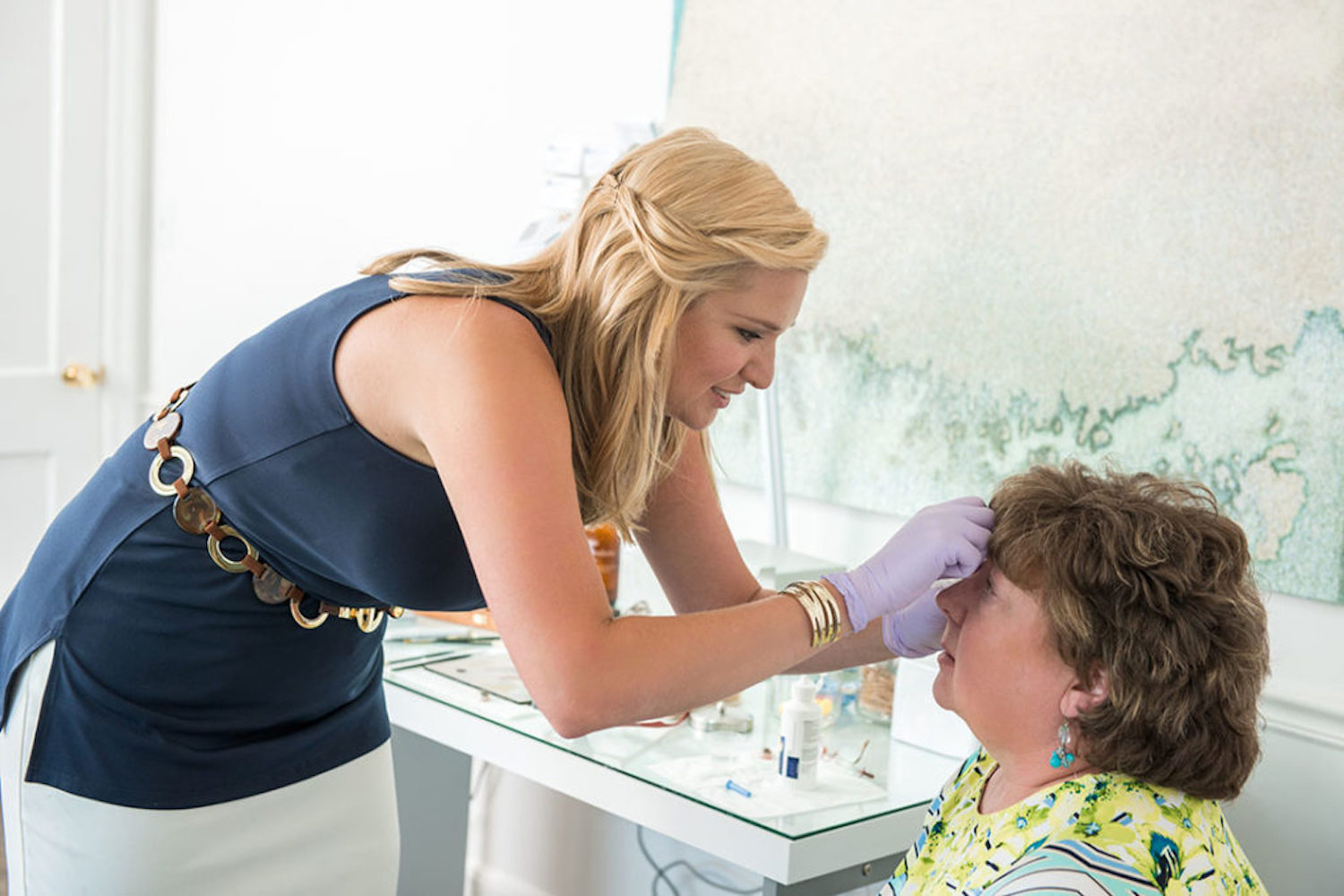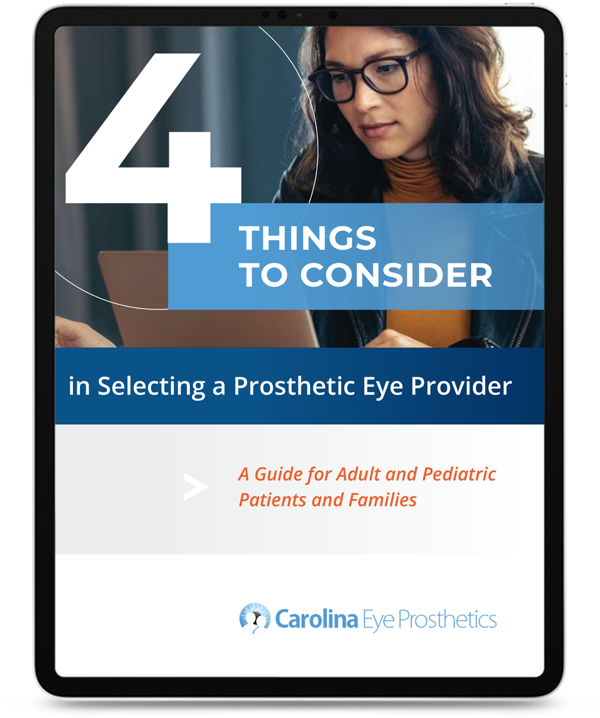What to Know About Prosthetic Eyes: A Patient FAQ Resource
Get clear answers to real questions about prosthetic eyes — how they work, how they’re made, and what to expect at each step with Carolina Eye Prosthetics.
If you’re exploring the option of a prosthetic eye for yourself or someone you care about, you may be looking for clear, honest answers, especially when the process feels unfamiliar or overwhelming at first. That’s why we’ve gathered the most common concerns, curiosities, and what-if scenarios we hear from patients every day. Whether you’re wondering how prosthetic eyes work, what they cost, or what your first appointment will be like, this guide is built to give you honest, practical answers from our team at Carolina Eye Prosthetics.

Understanding Prosthetic Eye Options
A prosthetic eye is a custom-made device that replaces the appearance of a missing or affected eye. It’s designed to look natural and fit comfortably in your eye socket. At Carolina Eye Prosthetics, each eye is crafted by hand to match your features and give you a more balanced, confident appearance.
While a prosthetic eye won’t restore vision, it does serve important functions, such as supporting eyelid movement, helping maintain facial structure, and protecting the eye socket. It can make a big difference in how you feel about your appearance, and many patients say they feel more like themselves once they have one.
Yes, some prosthetic eyes can move a little, depending on how your surgery was done. If your eye muscles were preserved, the artificial eye may follow your natural eye’s movement slightly. We’ll help you understand what kind of movement is possible in your case.
Modern prosthetic eyes are designed to blend in naturally. At CEP, we paint each one by hand to match your healthy eye as closely as possible. Most patients say it feels comfortable once it’s in place and forget they’re even wearing it.
A corneal scleral shell is a thin, custom cover that fits over an existing eye that may be damaged but still present. It’s a good option for people who want to improve the look and comfort of an eye that wasn’t removed. Like all our prosthetics, it’s made to match your natural appearance.
Most prosthetic eyes themselves are MRI safe. However, if you’ve had an orbital implant placed during surgery, particularly one with a metal peg, there may be some restrictions. If you’re unsure about your implant, we’ll help you confirm the details and talk with your provider if needed.
Living with a Prosthetic Eye
After your prosthetic eye is fitted, it’s normal to experience some mild discomfort as your eye socket adjusts. However, significant pain is uncommon. If you do experience persistent discomfort, it’s important to consult your ocularist to ensure the prosthesis fits properly and to address any underlying issues.
With proper care, a prosthetic eye can last several years. However, over time, changes in the eye socket or wear and tear may necessitate adjustments or replacements. Regular check-ups with your ocularist can help determine when updates are needed to maintain comfort and appearance.
Adjusting to a prosthetic eye varies for each individual. Many people return to their daily activities, including work and hobbies, with renewed confidence. Engaging in sports, driving, and social interactions is often possible. Emotional adaptation is also a part of the journey, and support from professionals and peer groups can be beneficial.
Have a Specific Question?
Every situation is unique. If you have a specific concern or need help understanding your options, we’re ready to help.
CONTACT USHow Carolina Eye Prosthetics Works
At CEP, we do more than create a prosthetic — we build relationships. Our patients are involved in every step of the process, from the initial consultation to the final fitting. Each prosthetic is crafted by hand, with real-time feedback and adjustments to ensure a natural look and comfortable feel. We’re known for our follow-up care, patient education, and lifelong support.
If you’ve recently had surgery, we’ll coordinate with your surgeon to make sure you’re fully healed before we begin. For others who are ready to move forward, such as those updating an existing prosthesis or receiving a scleral shell, we can often create your custom eye in just one day. Many patients are surprised at how streamlined the process is. If additional healing is needed, we’ll walk you through the timeline and keep you informed at every stage.
Yes. We care for patients of all ages, including infants and children. Pediatric cases may involve a gradual process called conformer therapy, where a series of fitted devices help prepare the eye socket over time. Our team works closely with families to ensure comfort, understanding, and the right timing for each step.

Anna’s artistic skills in drawing and coloring are incredible — the eye looks spot on. It pops in right over my smaller eye and blends so naturally. I couldn’t believe how quickly the whole process came together. We spent the day exploring Burlington, and by that afternoon, I had a new eye that looked like me.”
– Kristen Mitchell, CEP Patient
What to Expect During and After Your Visit
Your first visit to Carolina Eye Prosthetics is all about you, your story, and your needs. We’ll walk through your medical history together, take a close look at your eye socket or current prosthesis if you have one, and talk honestly about what’s possible. Whether you’re here for your first prosthetic, a replacement, or a fit check, our team will make sure you leave with a clear understanding of your next steps and a sense of support from day one.
Cleaning your prosthetic eye is straightforward, and we’ll show you exactly how to do it. Most patients rinse the prosthesis outside the socket using warm water and either mild soap or saline. At CEP, we’ll help you find a routine that fits your comfort level and daily life, so you always feel confident in your care.
There’s no single answer — some of our patients remove their prosthesis every day, while others do so just once in a while. We’ll talk with you during your appointment to find a rhythm that works best for your eye and your routine. If you start to feel discomfort or notice buildup, it might be time for a gentle cleaning or a quick visit to our office.
Paying for a Prosthetic Eye and Getting Started
Insurance coverage can be complex because coverage varies by provider and plan, and some insurers classify prosthetic eyes differently. At Carolina Eye Prosthetics, our team will explain what to expect, help you understand your benefits, and walk you through the next steps. We also provide billing codes so you can check directly with your insurance company. We don’t typically file on your behalf, but we’ll make sure you have the information you need to move forward.
For added flexibility, we also accept CareCredit and can discuss other payment options to help you get the care you need without added financial stress.
Because every prosthesis is custom-made, pricing depends on your specific needs, the type of prosthesis, and whether any medical or fitting complexities are involved. During your evaluation, we’ll talk openly about cost, discuss available payment options, and make sure you have time to consider your choices without pressure.
Ready to Get Started?
Hi, I’m Anna Boyd Jefferson, the ocularist here at Carolina Eye Prosthetics. If you’ve been reading through these questions and still have a few of your own, that’s completely OK. This process can feel like a lot at first, but you don’t have to figure it out alone. Whether you’re exploring your first prosthetic or thinking about an update, I’m here to help make things simple and clear.
Schedule an appointment or request a video consultation below.
We’re looking forward to hearing from you soon!


